Key issues
- In the week ending 3 July 2024, a series of low-pressure troughs and cold fronts brought rainfall to the southern half of Australia.
- Across cropping regions, rainfall was received across all states, with Western Australia and northern Queensland receiving a maximum of 100 millimetres; New South Wales, southern Queensland and South Australia received up to 50 millimetres; and Victoria received up to 25 millimetres.
- Over coming days, rainfall is forecast for much of the southern half of Australia. A low-pressure system associated with a cold front on the west and onshore flow associated with a high-pressure system on the east are forecast to bring up to of 50 millimetres of rainfall.
- Across cropping regions, rainfall is expected across all states with totals of between 5 and 50 millimetres forecast for South Australia and Western Australia; and a maximum of 25 millimetres across Queensland, New South Wales and Victoria. If realised, this rainfall is expected to further benefit winter crop establishment where upper layer soil moisture is critical at this stage of the crop growth.
- In June, national rainfall was 9% above average, and 35% above average for Western Australia. Upper- and lower-layer soil moisture was largely average to above average with isolated areas in the tropics and southern Australia having below average.
- June also saw 5 to 20 frost event days being recorded across eastern cropping regions. Where experienced, frost damage to emerging winter crops likely to have been minimal and localised in nature.
- For the 3 months to June 2024, above average rainfall totals resulted in average to extremely high pasture production across large parts of eastern and central Australia. This will likely enable farmers to maintain current stock numbers and provide opportunities to build standing dry matter availability. Below average to extremely low pasture growth rates were recorded across much of southern and eastern South Australia, southern and northern Western Australia and pasts of Queensland, and western New South Wales and Victoria. Graziers in these regions will be more reliant on supplemental feed to maintain current stocking rates and production.
- Water storage levels in the Murray-Darling Basin (MDB) increased between 27 June 2024 and 04 July 2024 by 9 gigalitres (GL). Current volume of water held in storage is 17 307 GL, equivalent to 78% of total storage capacity. This is 17 percent or 3,555 GL less than at the same time last year. Water storage data is sourced from the BOM.
- Allocation prices in the Victorian Murray below the Barmah Choke increased from $43 on 27 June 2024 to $147 on 04 July 2024. Prices are lower in the Murrumbidgee due to the binding of the Murrumbidgee export limit.
Climate
For the week ending 3 July 2024, a series of low-pressure troughs brought rainfall to the southern half of Australia. A low-pressure system in Western Australia brought widespread rainfall with totals of up to 100 millimetres across some coastal and central parts of the state. A cold front, in combination with a series of low-pressure troughs, brought up to 50 millimetres of rainfall across large parts of Victoria, coastal South Australia and New South Wales, up to 100 millimetres in Tasmania and a maximum of 150 millimetres across isolated areas of coastal Queensland.
Across cropping regions, rainfall totals ranging between 10 and 100 millimetres were recorded across much of Western Australia and Queensland. Falls of between 10 and 50 millimetres were recorded across central and north-eastern New South Wales, southern Victoria and southern South Australia. Rainfall totals of between 5 and 10 millimetres were recorded across most remaining cropping regions. Recent rainfall has likely benefited the establishment of winter crops, particularly in Queensland, Victoria and South Australia, and contributed to a build-up of soil moisture across the wheat/sheep zone.
Rainfall for the week ending 3 July 2024
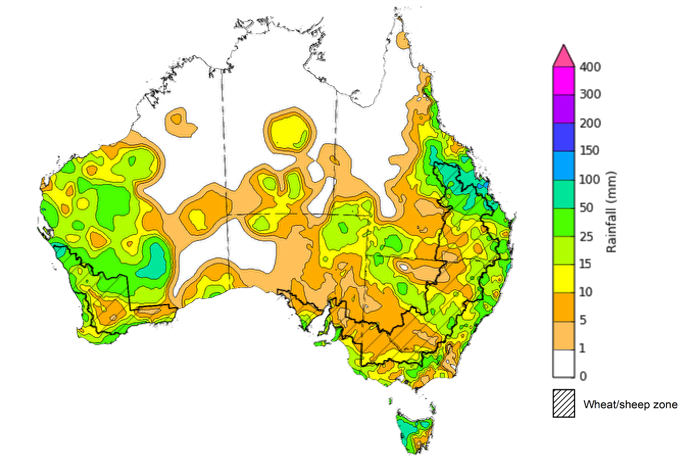
Issued: 3/07/2024
Over the 8 days to 11 July, rainfall is forecast for much of the southern Australia extending into central Queensland. A low-pressure system associated with a cold front is expected to bring falls up to 50 millimetres in the west, while onshore flow associated with a high-pressure system is forecast to bring a maximum of 50 millimetres to large areas of eastern Australia. Tropical moisture advancing over Queensland into eastern South Australia will generate storms and heavy rainfall of up to 50 millimetres. In the north, a high-pressure system is expected to keep parts of Western Australia, the Northern Territory, and Queensland largely dry.
Across cropping regions, rainfall is expected across all states with totals of between 5 and 50 millimetres forecast for South Australia and Western Australia. In the east, falls of between 5 and 25 millimetres is expected across much of Queensland, New South Wales and Victoria. If released, this rainfall is expected to support winter crop establishment where upper layer soil moisture is critical at this stage of the crop growth.
Total forecast rainfall for the period 4 July to 11 July 2024
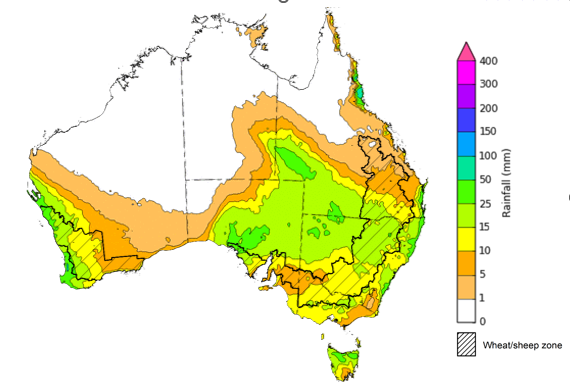
Issued 04/07/2024
Note: This rainfall forecast is produced from computer models. As the model outputs are not altered by weather forecasters, it is important to check local forecasts and warnings issued by the Bureau of Meteorology.
During June 2024, rainfall was 9% above average across the nation as a whole, and over 35% above average for Western Australia. Rainfall was well above average in large parts of Western Australia, eastern New South Wales and eastern Victoria, and across large areas of northern Australia. In contrast, the northern tropics, and parts of southern New South Wales, Victoria and South Australia, and south-western Western Australia recorded severe rainfall deficiencies.
In cropping regions, rainfall was mixed, with parts of northern Queensland, New South Wales, and Western Australia seeing well above average rainfall. In contrast, rainfall was below average to extremely low in parts of southern Victoria and New South Wales, and isolated parts of Western Australia.
Rainfall percentiles for June 2024
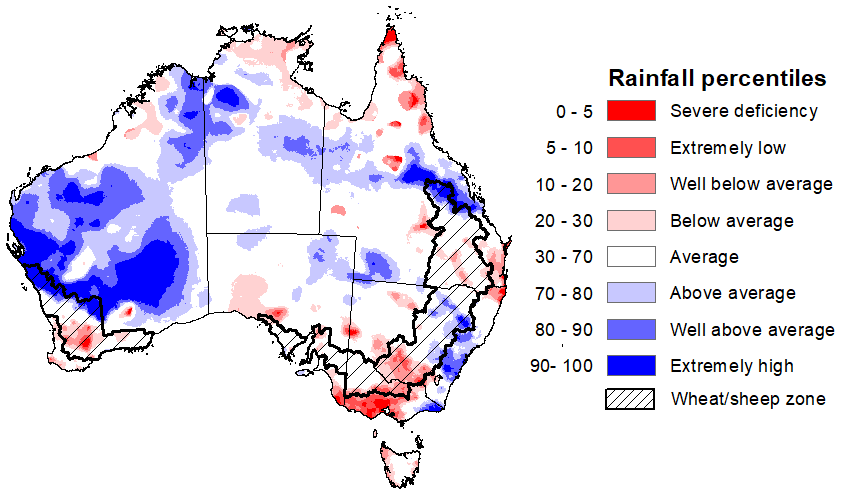
Source: Bureau of Meteorology
Upper layer soil moisture levels for June 2024 varied considerably, with the western part of the country generally having above average to very much above average soil moisture. High levels of upper layer soil moisture were modelled in Western Australia and parts of the Northern Territory, while isolated areas of the east coast of New South Wales and Victoria recorded above average soil moisture. In contrast, upper layer soil moisture was modelled to be below average in the Northern Tropics, isolated areas on the east coast of Queensland, and southern Victoria.
At this time of the year, upper layer soil moisture is important for the germination and establishment of early sown winter crops across Australian cropping regions.
Across cropping regions, upper layer soil moisture in June was modelled to be generally average in the east, while soil moisture in Western Australia was average to very much above average. In Queensland, soil moisture levels ranges from below average in the south to above average in the north of the state. In South Australia, Victoria, and New South Wales, soil moisture levels were generally average to above average. These soil moisture levels are likely to be sufficient to support the germination and development across most winter crops regions.
Modelled upper layer soil moisture for June 2024
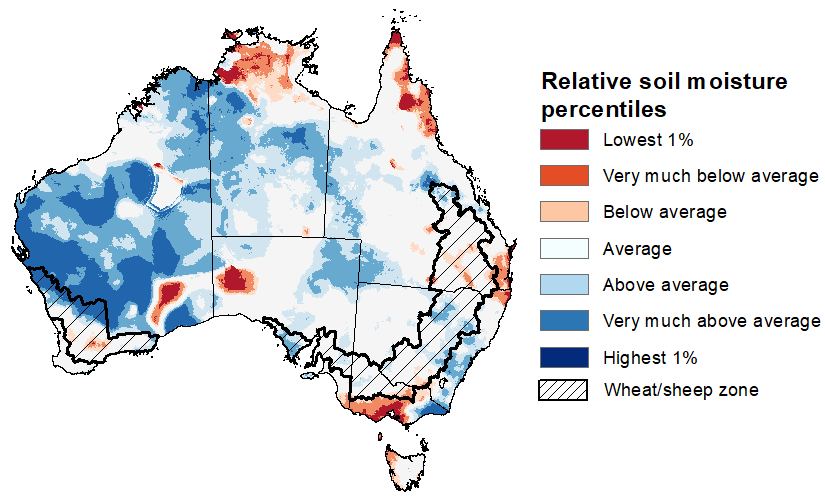
Source: Bureau of Meteorology (Australian Water Resources Assessment Landscape model)
Across northern Australia, lower layer soil moisture was average to very much above average in June. In contrast, large areas of extremely low lower layer soil moisture were evident across parts of southern Australia. Modelled lower layer soil moisture was generally average for remaining areas of Australia.
Lower layer soil moisture plays a pivotal role in sustaining the growth of winter crops and pasture during their critical development stages.
Across cropping regions, lower layer soil moisture generally ranged from average to above average in the east, with Queensland and northern New South Wales having average to very much above average soil moisture in scattered areas. In the west, lower layer soil moisture was mixed – northern Western Australian cropping regions were modelled to have very much above average soil moisture, while southern areas had very much below average soil moisture. In cropping regions of South Australia, Victoria, and southern New South Wales, soil moisture was below average to very much below average in June. These extremely low levels of stored soil moisture across much of South Australia, Western Australia and Victoria will mean that adequate and timely rainfall will be required during winter and spring to support the current level of forecast crop and livestock production.
Modelled lower layer soil moisture for June 2024
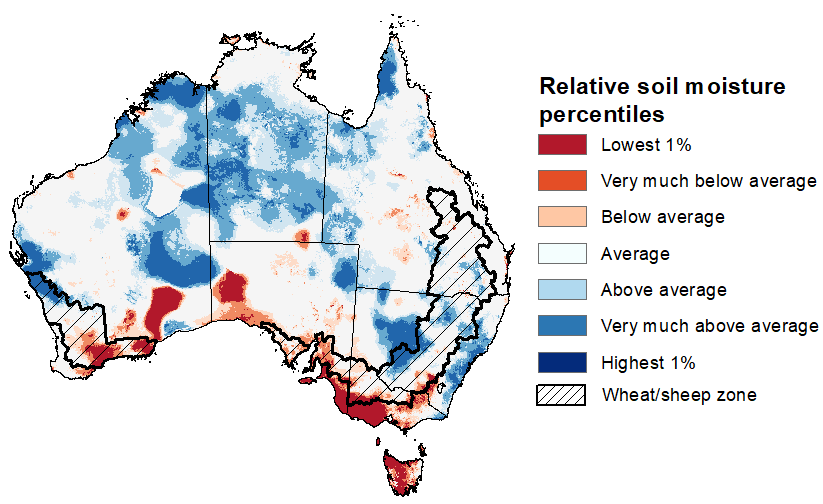
Source: Bureau of Meteorology (Australian Water Resources Assessment Landscape model)
Frost occurs on clear nights during the late autumn to early spring period, when the air temperature drops to 2°C or lower and is most pronounced in the southern and eastern agricultural regions. The weather events that typically generate damaging frosts are from the passage of cold fronts, followed by cold southerly winds and a high-pressure ridge. The severity and extent of subsequent damage is variable across the landscape. Crop damage from frost may occur at any stage of development but is most damaging around flowering and grain filling in spring. During the early stages of plant growth, frost can damage emerging crop.
Severe frosts (minimum temperatures below -2°C) can cause freezing damage to a crop when there is rapid ice crystal formation form within the tissue. The ice crystals physically rupture cell walls and membranes within the cells. Damage can be seen once thawed as dark green water-soaked areas. Ten days after a frost event, bleached leaves, stems and reproductive tissue might be evident depending on the growth stage of the crop.
During May 2024, potential frost events were recorded across southern New South Wales, Victoria and parts of eastern South Australia cropping regions. During June, much of Victoria, New South Wales and Queensland, and parts of eastern South Australia and central Western Australia cropping regions experienced at least 5 frost events. Depending on the growth stage of crops and the severity and length of time crops were subjected to frost, this presents a localised risk to crop production in these areas.
Number of days with minimum temperature below 2°C in May and June 2024

Note: Based on standard 30-year climatology (1993-2022)
![Map of the number of days minimum temperature was below 2°C in June based on historical climatology (1993-2022) and in the latest months. Data provided by the Bureau of Meteorology. Please refer to accompanying text for a more detailed description.]](/sites/default/files/images/frost-june-2024.png)
Note: Based on standard 30-year climatology (1993-2022)
As northern Australia enters the dry season, pasture growth typically declines significantly due to the reduction in water availability, with livestock relying on pasture grown throughout the previous wet season. As south-eastern Australia enters winter, pasture growth typically increases, reflecting higher rainfall totals, and reduced temperatures and evapotranspiration rates at this time of year. Pasture availability during this period influences the growth and branding and marking rates of lambs and calves, livestock turnoff and the production of meat, milk, and wool.
For the 3 months to June 2024, above average rainfall totals resulted in average to extremely high pasture production relative to this time of year across large parts of eastern and central Australia, extending into central Western Australia. Average to extremely high pasture production across grazing regions will likely enable farmers to continue to maintain current stock numbers and provide opportunities to build standing dry matter availability.
In contrast, below average to extremely low pasture growth rates were recorded across much of southern and eastern South Australia, southern and northern Western Australia and pasts of Queensland, and western New South Wales and Victoria. In Tasmania, parts of far-east Western Australia, northern South Australia, the Northern Territory, and the south-east coast, pasture growth is seasonally low. Graziers in these regions will be more reliant on supplemental feed to maintain current stocking rates and production.
Relative pasture growth for 3-months ending June 2024 (1 April to 30 June 2024)

Source: Department of Environment, Science and Innovation
Water
Water storages, water markets and water allocations - current week
The Tableau dashboard may not meet accessibility requirements. For information about the contents of these dashboards contact ABARES.
Commodities
Information on weekly price changes in agricultural commodities is now available at the Weekly commodity price update.
